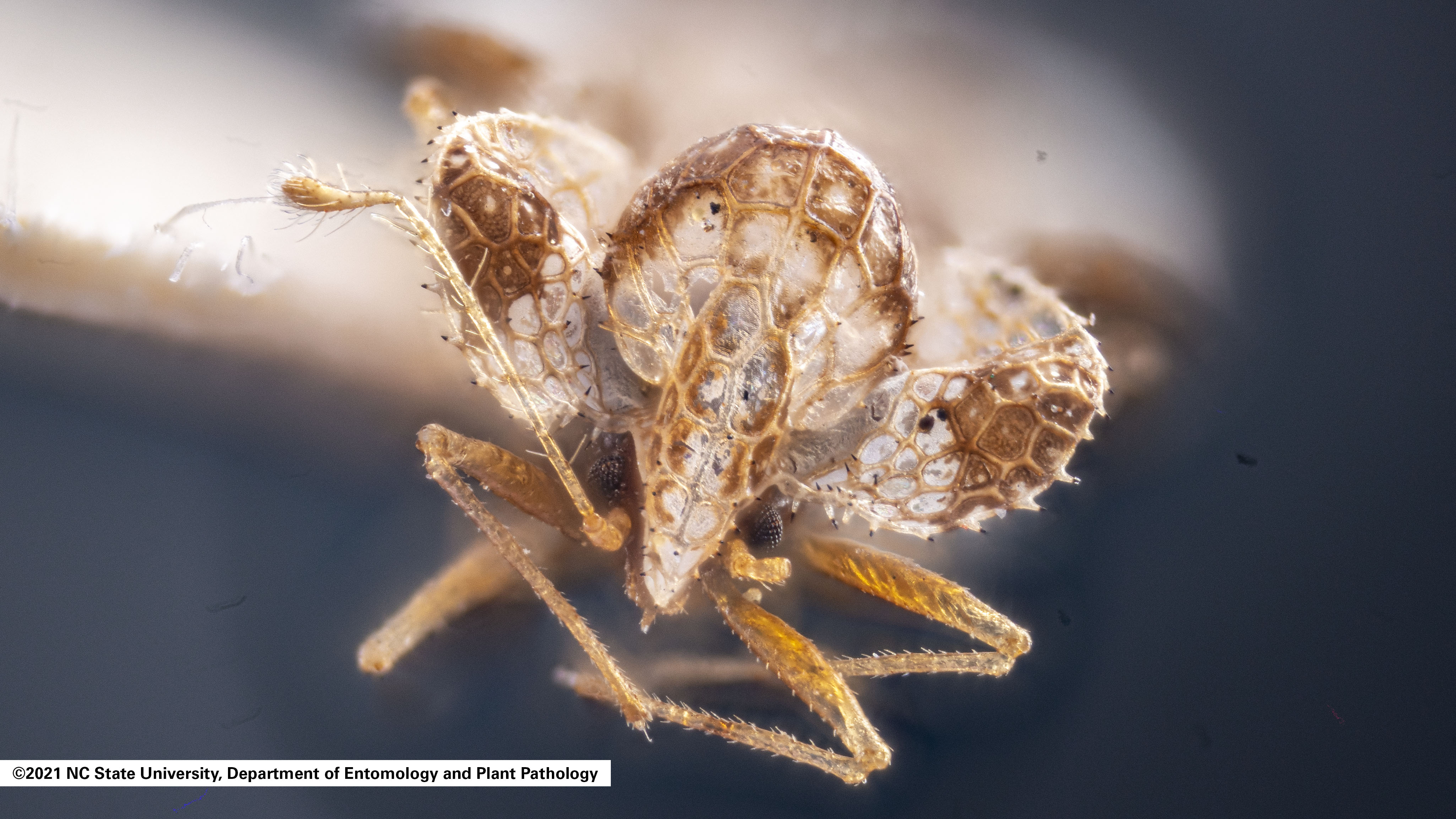A Metamorphosis: DELTA Grant Transforms ENT 410

We interact with insects all the time, especially in North Carolina. They live around us, keep ecosystems balanced and teach us about our environment. But how well do we know them? What if we could get up close and personal, examine their textures, spin them around and zoom in on their features (all without getting bitten or stung). In real life, that’s pretty difficult. In ENT 410: Turfgrass and Ornamental Insect Pest Management, that’s a normal day in class.
Through an extensive DELTA Grant, Extension Associate Terri Billeisen created ENT 410, a new course launching in 2022, based on student engagement strategies and innovative learning technologies. The content and activities developed for the DELTA Grant were also used to enhance the laboratory component of ENT 163: Ornamental and Turf Insects.
“I’d already been brainstorming ways to make the laboratory component of this course more engaging and wanted to involve more advanced technology to build enthusiasm among students. I envisioned creating a course where the laboratory and the technology really took center stage in teaching students how insects work, behave and accomplish everything that they do. It was inspired by having to transition to online learning, so it was not only creating an online course [option] but also having an online component to an existing course,” Billeisen explains.
Starting in fall 2020, she teamed up with Lead Multimedia Designer Rich Gurnsey, Assistant Director of Course Quality Bethanne Tobey, Multimedia Specialist Stephen Waddell and Immersive Media Producer Rhett Hissam to not only get the lab section of ENT 163 ready for the following semester but to create a new learning experience for ENT 410.
A Closer Look
The project sought to improve students’ ability to identify insects and their morphological features and increase students’ ability to categorize and name insects. Billeisen hoped to make ENT 410’s online laboratory as engaging as its in-person version, in which students examine insect specimens by hand. But even in person, this comes with its own challenges, like specimens getting damaged and fine details proving hard to pinpoint to a whole class.
The project wrapped with a wide array of deliverables, the first being a redesigned lab component. The team got started by looking at the lab holistically and brainstorming ways to make it more engaging. In order to create a quality online experience by the spring semester, Gurnsey began sourcing high-resolution photographs and 3D models of the course’s insect specimens, which were then loaded into the Virtual Viewer, a digital magnification tool created for a previous DELTA Grant. The team is also in the process of developing a new identification tool similar to the Virtual Viewer, which Billeisen was able to access during the course of the project.
“With this tool, you can zoom in on these high-resolution photos [and 3D models] and examine the different parts of insects. That really helps replicate the experience of examining an actual physical insect specimen, and it’s even better because students aren’t going to break off any legs, the specimens won’t degrade over time, and users can perhaps see even more detail than you would with a physical specimen,” Gurnsey explains.
Sourced materials were helpful in getting the new course components ready for a soft launch in spring 2021, but the team wanted to go a step further by creating their own digital media based on the course’s physical specimens.
“I was able to get some specimens from Terri, and the first thing I tried was photogrammetry work using a combination of different techniques,” Waddell says. “The hope was that we could provide our own sources for some of the insects that they weren’t able to source in 3D, as well as a lot of photography. The core goal was to provide the photography for all those specimens she handed over.”
Photogrammetry is similar to taking a 3D photograph. Waddell set up a lightbox in his home, where he placed Billeisen’s specimens on a turntable and lit them from all angles. A camera then took a large number of images while each specimen turned, and photogrammetry software gathered all of these images and put them together into one 3D model.

To make this process more complex, Waddell was handling near-microscopic specimens, such as a lace bug.
“I thought for a moment that I mishandled it, that it was at the bottom of the jar somewhere, but it was just it was so small that I needed a magnifying lens to get some proper photos of it. I 3D-printed a small resin adapter that made it possible to use objective lenses from a microscope on a digital single-lens reflex (DSLR) camera and some of the photos that we delivered were taken with that,” Waddell says.
Next-Level Learning
To help students identify and navigate the taxonomy of these digital specimens, Gurnsey and Tobey created a dichotomous key tool for use in Moodle. Billeisen’s original key existed as a simple document with yes or no questions.
“I started by transforming the key into a flow chart to visualize how you would follow a path to the insect you’re trying to identify. Then Bethanne took that flow chart and made a digital version in Moodle where the questions pop up on screen and your answers lead you to the insect you’re looking for, along with its photo. It’s super-intuitive and less unwieldy than the typical dichotomous key,” Gurnsey says.
Students apply what they learn from the dichotomous key tool in the Turf Insect Grid Sampling Activity. ENT 410 prepares students to identify, diagnose and control turfgrass pests, so this activity mimics how students might work in the field. They look for insects by examining an interactive grid on a photo of a golf course or another turf-grass environment. By clicking on the grid, students find out the number of insects that are present in each sector. Students then calculate the number of insects across the environment and create a pest control plan.


Developing ENT 410’s Moodle course was a major part of the project. With Billeisen accustomed to teaching with Top Hat, Tobey helped her set up a Moodle course that aligned with Quality Matters (QM) standards. They began by creating a course map, which allowed them to look at the content holistically, examine how it meets course objectives and fill in missing pieces.
“The lab is fully aligned, which means that all the course objectives and each week’s objectives have meaning and that if the students successfully complete a lab and all the activities within it, they’ve met those objectives. [ENT 410] also uses a student support block, letting students know how the course is structured and how communication back and forth between the instructor is expected to happen,” Tobey explains.
Billeisen had taken QM training before and received some credentials, but when it came time to apply this learning, she was a little nervous. However, once she and Tobey got to work, she knew they were heading down the right path.
“As soon as Bethanne mentioned a course map, I was like ‘Oh no.’ I knew this was going to take a long time and I saw the value of it, but since I wasn’t forced to do it, I hadn’t done it yet,” Billeisen shares. “It feels time-consuming and tedious, but it is so worthwhile to pinpoint what’s in your course currently that either may not be a good fit or is not accomplishing what you want it to. It makes it so much easier to come up with ideas for new activities because it’s basically a bunch of arrows pointing to one thing, and then you only have so many options on how you’re going to do it, so it actually focuses your brain and makes different aspects of your course so much more intentional.”
A Ripple Effect
With so many useful outcomes, Billeisen sees this project benefiting her students for a long time to come.
“For any teacher, creating and building student engagement is usually the primary goal. You always want your students to be interacting with the material. Otherwise, it just feels like kind of a waste. Anytime you can incorporate new activities –– especially when they’re based online so anyone can access them –– is a huge factor in the success of creating that engagement,” she says.
Since most of the project was ready by spring 2021, halfway through the grant period, students in ENT 163 were able to provide feedback that the team built on in the second half of the project. Billeisen’s students have said they love the new content, which not only helps them understand course material but also build soft skills as they interact with new technology and explore digital platforms.
With this success, Billeisen hopes to apply the same technology and techniques to other courses.
“A lot of these activities can be easily modified to move into either another entomology course or even moving outside of that. Especially within the sciences, a lot of the stuff that we’ve developed can be used, in a broad sense, anywhere. You keep the framework the same, you just change the content that’s within it, so I think a lot of what we came up with has the potential to be used in a lot of different classrooms.
“I think students, no matter what age they are, like switching up the regular lecture routine. That’s what’s cool about DELTA Grants, in general, is that a lot of times you’re generating these programs or platforms that you can easily use or switch between different courses. No one could have foreseen the transition to fully virtual learning, so anytime you can take something and put it online, it may not be the same as the in-person experience but it is learning the material just in a different way,” Billeisen adds.
DELTA sees this kind of impact as a ripple effect.
“By setting best practices, it’s raising the bar for the quality of courses that students can take at NC State. As we continue to work with faculty to make those improvements to a course, students begin getting exposed to the consistency of that type of course design and lab design,” says Tobey.
Looking back on the DELTA Grant now, Billeisen is sad to say goodbye.
“It was such a great experience, and we created something really substantial and wonderful that I’m going to continue to use for years. My interactions with the DELTA team were my favorite part of the whole thing. I would recommend it to anyone.”


